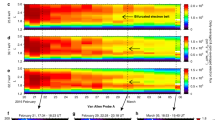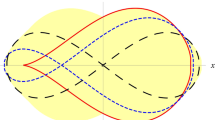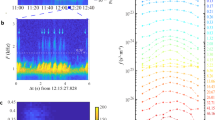Abstract
v.l.f. emissions associated with the enhancement of ring-current electrons during magnetic storms and substorms have been detected by the satellite S3-A (Explorer 45) on an equatorial orbit1,2. The emissions observed near the geomagnetic equator consist of essentially two frequency regimes; one above the electron gyrofrequency at the equator, fH—the electrostatic mode3–5, which peak near (n+1/2)fH, where n is positive integer (emissions up to n = 10 have been observed2)—and the other below fH—the whistler mode, which has a conspicuous gap at exactly fH/2. Here we describe the characteristics of this v.l.f. emission and the associated enhancements in electron intensity as well as the anisotropies of the ring-current electron distribution, and we also give an interpretation of the bimodal frequency distribution of the equatorial whistler mode emissions. This distribution has been known for the past few years but has not been well explained6,7.
This is a preview of subscription content, access via your institution
Access options
Subscribe to this journal
Receive 51 print issues and online access
$199.00 per year
only $3.90 per issue
Buy this article
- Purchase on Springer Link
- Instant access to full article PDF
Prices may be subject to local taxes which are calculated during checkout
Similar content being viewed by others
References
Maeda, K., Planet. Space Sci., 24, 341 (1976).
Anderson, R. R., and Maeda, K., J. geophys. Res. (in the press).
Kennel, C. F., Scarf, F. L., Fredericks, R. W., McGehee, J. H., and Coroniti, F. V., J. geophys. Res., 75, 6136 (1970).
Bernstein, I. B., Phys. Rev. 109, 10 (1958).
Stix, T. H., Theory of Plasma Waves (McGraw Hill, New York, 1962).
Tsurutani, B. T., and Smith, E. T., J. geophys. Res., 79, 118 (1974).
Gendrin, R., Space Sci. Rev. 18, 145 (1975).
Parady, B., and Cahill, L. J., J. geophys. Res., 78, 4765 (1973).
Anderson, R. R., and Gurnett, D. A., J. geophys. Res., 78, 4756 (1973).
Lyons, L. R., and Williams, D. J., J. geophys. Res., 80, 943 (1975).
Liemohn, H. B., J. geophys. Res., 72, 39 (1967).
Matsumoto, H., and Kimura, L., Planet. Space Sci. 19, 567 (1971).
Smith, R. L., Helliwell, R. A., and Yabroff, I., J. geophys. Res. 65, 815 (1960).
Angerami, J. J., J. geophys. Res. 75, 6115 (1970).
Helliwell, R. A., Whistlers and Related Ionospheric Phenomenon (Stanford University Press, 1965).
Kimura, I., Radiosci., 1, 269 (1966).
Burtis, J. W., Tech. Rep., 3469-3 (Stanford Radioscience Laboratories, 1974).
Author information
Authors and Affiliations
Rights and permissions
About this article
Cite this article
MAEDA, K., SMITH, P. & ANDERSON, R. v.l.f. emission from ring-current electrons. Nature 263, 37–41 (1976). https://doi.org/10.1038/263037a0
Received:
Accepted:
Issue Date:
DOI: https://doi.org/10.1038/263037a0
This article is cited by
-
Theoretical and numerical studies of chorus waves: A review
Science China Earth Sciences (2020)
-
Effect of parallel electric field and geomagnetic field distortion on precipitation of charged particles into the lower ionosphere
Journal of Earth System Science (1984)
-
Adiabatic-drift-loss modification of the electromagnetic loss-cone instability for anisotropic plasma
Astrophysics and Space Science (1980)
Comments
By submitting a comment you agree to abide by our Terms and Community Guidelines. If you find something abusive or that does not comply with our terms or guidelines please flag it as inappropriate.



